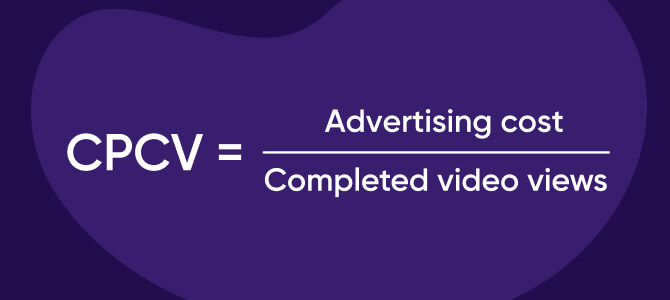
Cost per completed view (CPCV)

Ad pricing model that stands for Cost Per Completed View, which is calculated by dividing advertising cost by completed video views
What is CPCV?
Cost Per Completed View is an ad pricing model where advertisers only pay for a video ad once the user watches a video in its entirety, which helps target high-quality users at a much lower risk for advertisers. Advertisers pay one flat rate for every completed video view, usually after a campaign hits a certain KPI threshold (such as minimum spend).
How to calculate CPCV
The formula to calculate CPCV is as follows:

Essentially, you are dividing the total cost of your video ad campaign by the number of users who completed the video.
For example, let’s say you’re an advertiser who spends $5,000 on a video campaign, which resulted in 500 completed views. The CPCV would be calculated as:
$5,000 / 500 = CPCV
CPCV = $10
Like most video pricing models, the lower the CPCV, the better.
Why should you use it?
The most prominent pricing models for video advertising are Cost per Thousand Impressions (CPM) and Cost per View (CPV). However, one of the biggest challenges for advertisers is transparency in metrics.
Video ads oftentimes have low visibility and CPMs don’t effectively measure the success of a campaign. A CPCV pricing model assures that you’re paying for high-quality users who have full visibility of your ad, minimizing potentially wasted ad spend.
Not all ad networks and publishers offer CPCV pricing, primarily because video ad completion rates on mobile are generally low. CPCV pricing improves transparency and trust between advertisers and publishers.
Alternatively, unskippable video ads are also an option, but may create a strain on user experience. However, when paired with rewarded advertising ads, publishers and networks can better predict the success of video ad campaigns.
Pro Tip: Rewarded video ads offer app users in-app rewards in exchange for a video completion.
One thing to note is that the definition of “video completion” differs across platforms. For example, YouTube counts 30 seconds as a full view, while Facebook and Instagram counts 15 seconds for videos, and 3 seconds for stories.
And like any other ad pricing model, nothing is guaranteed. A completed video view is not necessarily more effective than another metric like click throughs. With that, marketers must always test out different pricing strategies that work for their specific audiences.
What’s the difference between CPCV, CPV, and CPM?

Cost per View, or CPV for short, is also a common pricing model where advertisers pay for a video impression or a video view of 1 second or more. Similarly, CPM (cost per thousand impressions) is also a common pricing model that is calculated by the following formula:
CPM = (Total Campaign Spend / Total Impressions) x 1,000.
A target CPM is often determined by the marketer before running the ad campaign, which is determined by the publisher’s premiums, geography, device types, and targeting specificity.
In contrast, CPCV more effectively measures the actual engagement rates of a user, whereas CPV and CPM may be used for broader top-of-funnel campaigns at a lower cost. Marketers may also use CPV and CPMs for larger-scale brand awareness campaigns in comparison to CPCV for performance-driven campaigns focused on measuring conversions.
How to improve your CPCV?
1. Ad Rotation: Rotate at least two to three ad creatives in your auction to reduce ad fatigue and gather more data on what types of videos perform best.
2. Improve your hook: The first five seconds of every video ad is crucial to reel in the user’s attention. Experiment with different openings in your testing.
3. Start with CPI then optimize with CPCV: To find the right target audience, begin your campaign by optimizing for Cost per Install (CPI). Once you narrow down to a focused audience, use CPCV to build on your CPI campaign to generate ongoing revenue.
4. Use vertical and square mobile aspect ratios: Diversify your video creatives to optimize performance for different device sizes. This may include the following: landscape 16:9, vertical 9:16, and square 1:1.
5. Broaden your audiences: The more targeted your ad, the higher the competition will be. If your CPCV is too expensive, broaden your target audience to help identify new audiences that may be more profitable.
Key takeaways
- CPCV is an ad pricing model that stands for Cost Per Completed View, where advertisers only pay for a video ad when watched in its entirety.
- CPCV is calculated by dividing advertising costs by completed video views
- CPI, CPM, and CPV campaigns are broader and more common ad pricing models but less effective at measuring engagement than CPCV
- The best ways to optimize CPCV campaigns is to use multiple aspect ratios, improve your video hooks, experiment with ad rotations, and build on CPI campaigns.



